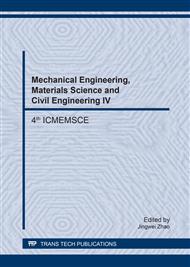[1]
P. Guo, H. Song, and X. Chen, Electrochemical performance of graphene nanosheets as anode material for lithium-ion batteries, Electrochem, commun, 11 (2009) 1320-1324.
DOI: 10.1016/j.elecom.2009.04.036
Google Scholar
[2]
H. Buqa, M. Holzapfel, F. Krumeich, C. Veit, and P. Novak, Study of styrene butadiene rubber and sodium methyl cellulose as binder for negative electrodes in lithium-ion batteries, J. Power Sources. 161. 1 (2006) 167-622.
DOI: 10.1016/j.jpowsour.2006.03.073
Google Scholar
[3]
J. Zhang, Z. Xie, W. Li, S. Dong, and M. Qu, Carbon, High-capacity graphene oxide/graphite/carbon nanotube composites for use in Li-ion battery anodes, Carbon. 74 (2014) 153-162.
DOI: 10.1016/j.carbon.2014.03.017
Google Scholar
[4]
S.F. Lux, F. Schappacher, A. Balducci, S. Passerini, and M. Winter, Low cost, environmentally benign binders for lithium-ion batteries, J. Elctrochem. Soc. 157. 3 (2010) A320-A325.
DOI: 10.1149/1.3291976
Google Scholar
[5]
Y. -S. Park, E-.S. Oh, and S. -M. Lee, Effect of polymeric binder type on the thermal stability and tolerance to roll-pressing of spherical natural graphite anodes for Li-ion batteries, J. Power Sources. 248 (2014) 1191-1196.
DOI: 10.1016/j.jpowsour.2013.10.076
Google Scholar
[6]
H.K. Park, B.S. Kong, and E.S. Oh, Effect of high adhesive polyvinyl alcohol binder on the anodes of lithium ion batteries, Electrochem. Common. 13 (2011) 1051-1053.
DOI: 10.1016/j.elecom.2011.06.034
Google Scholar
[7]
M. -H Jo, J. H Kim, and S. -K Jeong, International Conference on Smart Material Technologies, ICSMT (2016) T009.
Google Scholar
[8]
Z. Ogumi and M. Inaba Bull, Electrochemical Lithium Intercalation within Carbonaceous Materials: Intercalation Processes, Surface Film Formation, and Lithium Diffusion, Chem. Soc. Jpn. 71 (1998) 521-534.
DOI: 10.1246/bcsj.71.521
Google Scholar
[9]
D. Aurbach, E. Zinigrad, Y. Cohen, and H. Teller, A short review of failure mechanisms of lithium metal and lithiated graphite anodes in liquid electrolyte solutions, Solid state ionics. 148. 3 (2002) 405-416.
DOI: 10.1016/s0167-2738(02)00080-2
Google Scholar
[10]
M. Dahibi, F. Ghamouss, F. T. -Van, D. Lemodant, and M. Anouti, Comparative study of EC/DMC LiTFSI and LiPF6 electrolytes for electrochemical storage, J. Power Sources. 196. 22 (2011) 9743-9750.
DOI: 10.1016/j.jpowsour.2011.07.071
Google Scholar


